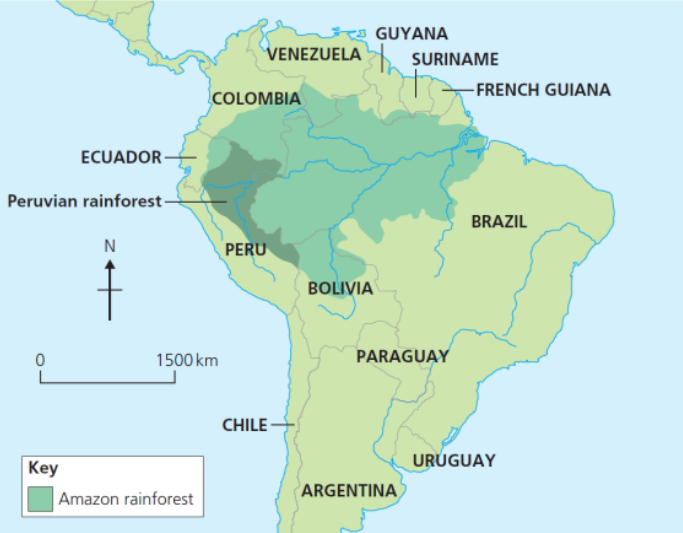Case study: Peruvian Amazon
1/12
There's no tags or description
Looks like no tags are added yet.
Name | Mastery | Learn | Test | Matching | Spaced |
|---|
No study sessions yet.
13 Terms
Where is the Peruvian Amazon?
Northeast Peru, South America

How much of Peru is covered by the Peruvian Amazon?
60%
What is the average temperature in the Peruvian Amazon?
28°C
What is the annual rainfall in the Peruvian Amazon?
2600mm
Why is Peruvian Amazon important?
Biodiversity → The home to 44% of all bird species & 63% of mammals, has around 3000 species, 16% of which exist nowhere else
Archaeology → Has the remains of ancient civilisations such as the Cachapoyas
Indigenous tribes → Home to many traditional tribes that live sustainably in remote parts of the rainforest
Medicinal plants → Some plants in the rainforest can help treat diseases such as cancer, 70% of plants with anitcancer properties can only be found in the Amazon (e.g. Lapacho Handroanthus impetiginosus)
How is the Peruvian Amazon under threat from human activity?
Timber
Energy
Mining
Roads
Agriculture
Timber
Hardwood trees in the rainforest (e.g. mahogany) are cut down to be used for furniture & construction
Around 95% of logging is unregulated & illegal
This results in deforestation, destroying vast areas of the rainforest
Energy
The Peruvian Amazon has large reserves of oil & gas
China has invested in oil extraction in the Madre de Dios region, which is home to 10% of the world’s bird species, which makes them vulnerable to endangerment
Oil spills damage ecosystems & pollute rivers
There are plans to construct up to 15 dams in the Peruvian Amazon so that more electricity can be exported to Brazil
Mining
Gold can be mined in the Peruvian Amazon from alluvium in rivers
This leads to toxic chemicals (e.g. mercury) polluting water
Illegal mining is appealing to many local farmers as they can make up to 10-100 times more in a day of mining than in a month of farming
Roads
The Trans-oceanic Highway is a road project that plans to connect a major Brazilian Highway to the Pacific ports in Peru
This will cause significant rainforest loss & make illegal logging & mining more accessible
Agriculture
Lowland areas in the Peruvian Amazon are being cleared for cattle ranching & the cultivation of crops (e.g. soyabean)
Fires that are used to clear land can burn out of control & lead to widespread habitat destruction
How have sustainable management strategies in the Peruvian Amazon been successful?
→ Deforestation due to gold mining has decreased by 95%
→ Illegal mining has become less attractive as miners can be sent to court in 48 hours, sentenced in 8 days & put in prison for 12 years
→ Indigenous tribes have been given land ownership & can control the use of their land
→ National Parks & Reserves protect areas with high biodiversity
→ In 2015, The Purus Manu Conservation Corridor comprises several national parks and reserves, making it the largest protected area in Peru with 10 million hectares
How have sustainable management strategies in the Peruvian Amazon been not successful?
→ Illegal mining & logging camps are destroyed with explosives, harming the surrounding ecosystem
→ Military forces are severely out numbered with 1800 military against 40000 illegal miners
→ Illegal miners & loggers move elsewhere in the vast rainforest, making them difficult to track